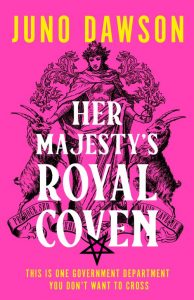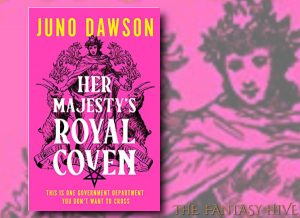HER MAJESTY’S ROYAL COVEN by Juno Dawson (BOOK REVIEW)
‘Hello, and thank you for expressing an interest in Her Majesty’s Royal Coven.’
Her Majesty’s Royal Coven
Juno Dawson
Both history and future are fictions. Only the present is real
Inst: @junodawson @harpervoyager_uk Twitter:HarperVoyagerUK @jundawson
Juno Dawson is a bestselling novelist, screenwriter, journalist, and a columnist for Attitude Magazine. Juno’s books include the global bestsellers, THIS BOOK IS GAY and CLEAN. She won the 2020 YA Book Prize for MEAT MARKET. Her first adult fantasy trilogy HER MAJESTY’S ROYAL COVEN arrives in July 2022.
To the mother I swear
To solemnly uphold the sacred sisterhood
Her power is mine to wield
The secret ours to keep
The earth ours to protect
An enemy of my sister is mine
The strength is divine
Our bond everlasting
Let no man tea us asunder
The coven is sovereign
Until my dying breath.
 Dawson’s novel, which came out on the 21st of July, has already reached the number one spot for many reviewers, readers, and booksellers alike. Her Majesty’s Royal Coven, has bewitched those who have dared to enter Dawson’s magical world, leaving every reader spellbound and addicted, salivating for the next novel’s emergence, HMRC: The Shadow Cabinet.
Dawson’s novel, which came out on the 21st of July, has already reached the number one spot for many reviewers, readers, and booksellers alike. Her Majesty’s Royal Coven, has bewitched those who have dared to enter Dawson’s magical world, leaving every reader spellbound and addicted, salivating for the next novel’s emergence, HMRC: The Shadow Cabinet.
25 years ago, 5 teenage girls are hiding in a tree house. Helena, Leonie, Elle, Niamh, and Ciara are bickering about Boyzone and the Spice Girls, causing an unbelievable pang of nostalgia for the reader whilst engendering an instant connection to these characters as well as the narrative at large. They could be any of us when we were younger, huddled in a tree house eating snacks, and preparing for the next day. For us, it might have been the school disco, our S.A.T exams, or our first day of high school. But for the five teenagers at the start of Her Majesty’s Royal Coven (named for the witch’s coven within the narrative, nicknamed HMRC throughout), the summer solstice is looming, and they are practising to be initiated into the coven. For these five girls are witches, and it is time for them to take their rightful places within a British coven which was founded by Anne Boleyn in the 1600’s; Her Majesty’s Royal Coven.
We work as a team to support the UK government in the handling of supernormal events and incidences
After meeting our young witches, the narrative skips 25 years to the present day. To a time after war; a time of precarious peace and quiet, a time that is something like now. Dawson’s narrative is constructed with magical realism in mind; the primary technique being to nestle the narrative in plain sight, amongst familiar and recognisable places and settings, but with the added benefit of ‘magic,’ to prevent non-magical people acknowledging any of the magic or ‘supernormal events,’ that might happen around them.
‘That’s him,’ […] cloak the whole street.’
Stray pedestrians strolled by, blind to what was happening. Sandhya’s cloaking spell was evidently working. They weren’t technically invisible, but mundanes wouldn’t see them either. Sandhya was planting a very simple instruction in their minds over and over: nothing to see here.
Whilst the settings and narratives are built into the contemporary world of mobile phones and teenagers obsessed with the internet, there is a magical underbelly that Dawson exposes and allows her readers to enjoy. I do admit, I was nervous that there would be lots of nods towards J. K. Rowling’s wizarding world of Harry Potter or other familiar tasting aspects of magical realism, but I was pleased to find very few. The only notable nod being that non-magical people are called ‘mundanes’ (or HOLA? ‘Humans of Limited Ability’), a tenuous but notable similarity to Rowling’s ‘Muggles’ (or mud-bloods). Unlike Rowling’s witches and wizards, all of Dawson’s magical-folk have particular abilities/powers and these can be measured by a level system (that I won’t pretend I followed accurately), with an insistence that witches have more power, strength, and control over their given powers than any warlock could possibly have.
Esther Jackman didn’t pretend to understand the life-style, as she called it, but always asked after their respective covens.
Whilst there are few allusions to contemporary magical-fiction, there was lots of historical context (some true and worth acknowledging, and some fabricated but also worth acknowledging). Dawson freckles her work with fragments of interesting historical snippets, about the world and witchcraft, concepts of Gaia, and a variety of religious beliefs/practices which mix into a tasty cocktail of what ‘witch-craft’ means in the world of HMRC.
Both history and future are fictions. Only the present is real. Remember that.
Whilst there are good and bad magical practices occurring within the narrative, from summoning demons, to necromancy, to helping ease the passing of dying animals – I will let you judge for yourself which you find good or bad-, the general reason for those possessing witchy-powers having been ‘given’ power in the first place, is to protect and watch over the Earth (Gaia). Much like modern Paganism (Wicca) may have been inspired by ancient belief structures and concepts regarding taking care of the earth, Dawson’s witches feel protecting over the earth, and feel power in it. And in this they can draw strength from nature and the natural world.
Night is thickest between two and three in the morning. Dawn is hours away and no one has any honest business being awake.
Helena banked on it.
Naked and barefoot, she strode into the pasture. The sky was overcast with thin cloud and the waxing moon was oddly lilac.
One of the most powerful aspects of Dawson’s work concerns the incredible identity journeys that take place within the story. Dawson delicately and beautifully deconstructs social constructs of gender and identity, by using magical identities (witches and warlocks) and the expectations that these types of identities carry. Whilst the narrative takes place within magical social constructs and hierarchies, very real social issues are confronted and challenged, such as Racism, Transphobia, and Homophobia, as well as exploring a plethora of problematic treatment of peoples and inclusion issues. As if being a teenager wasn’t hard enough, Dawson’s characters have got to contend with hormones, new magical powers, as well as the old coven ‘traditions,’ which were constructed before any of the feminism movements began. Those who breach constructed social boundaries in the novel are treated as more than ‘Other’ and rejected, by some of the characters, and embraced whole heartedly by others. Interestingly, Dawson chose for the High Priestess (Helen Vance) to embody all the problematic leftover attitudes of our darker ages, and she is eventually overthrown. A beautiful triumph for all the HMRC witches.
‘Helena Vance is a TERF. Why are people so fucking disappointing’
Dawson’s novel is a triumph. After a mixed-bag of a year in regards to magical realism, from the incomparable novel ‘The Atlas Six,’ by Olivie Blake, to other less successful magical novels that I will not title, I was uncertain as to what to expect for Her Majesty’s Royal Coven. I am delighted to admit that I was anything but disappointed, I did not realise this was the first novel of three until I had finished reading this one, and I was thrilled to learn another was coming. This novel stressed me out, made my heart thump, and my blood boil. However, this novel also made me smile, laugh, and engendered lots of tears (which means it packed an emotion punch).
Juno Dawson, you have put a spell on me, bring on: HMRC: The Shadow Cabinet

